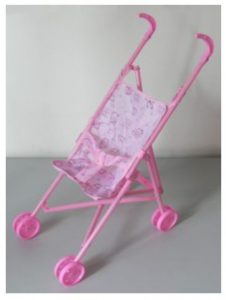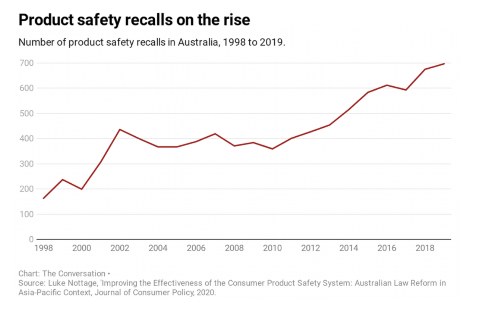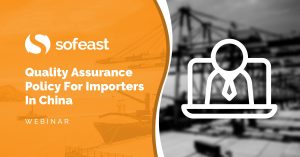Recently I read an article that calls for manufacturers to be more proactive in reducing risks for consumers. And they shared this (pretty scary) graph about product safety recalls:
Many companies that develop & purchase products wonder how to minimize the risk of a forced recall, which can be extremely expensive.
And my advice is simple:
Put more effort into assuring the quality and the reliability of your products and it will greatly contribute to their safety.
Let’s unpack these three concepts.
A) What is product safety?
A safe product does not harm its users.
Typical metrics are the number of incidents and the number of near-miss incidents.
(These metrics can only be assessed when it is too late, unfortunately. Users have already been affected. Preventively, safety professionals tend to quantify risks and work on reducing them.)
Let’s take an example. This product led to a recall because 137 laceration injuries to the hands and fingers were recorded. It looks like a very big oversight in the design of the product is at the root cause of this hazard.

The US CPSC website, as well as the EU RAPEX system, are full of examples of unsafe products: watches with a battery that catches fire, jewellery that contains lead, adaptors which can lead to an electrical shock, toys that contain too many phthalates, and so on and so forth.
Brands and retailers usually send samples to a compliance testing laboratory. For example, if the product falls within the scope of the REACH directive, the product will be tested for the presence of certain restricted substances.
Poor safety, in such an example, usually comes from:
- Poor understanding of users (i.e. how will they use it?)
- Poor definition of requirements (e.g. ‘nothing that can cut a finger/hand can be detached unintentionally’, which would be translated into technical requirements for the type of materials, for the tolerances, and for the attachment mechanisms), which of course relate closely to CPSC regulations
- Poor testing of the requirements (e.g. after opening & closing 1,000 times, all the dangerous components still stay well in place, and they haven’t got to the point where the blades are dull and the user has to make moves that are not desired)
- Poor testing of assumptions (e.g. is it true that typical users will never be tempted to put their fingers in the “danger area”?)
- Poor manufacturing of components and/or poor assembly
- In case there is a residual amount of risk, poor education of the user in the form of warning stickers, user manual, etc.
Isn’t safety just about compliance?
Noticed something in the list above? Everything is related to quality and/or reliability.
That’s why, when people say “compliance to applicable regulations will ensure safety”, they might be right… but they often tend to overlook the fact that quality + reliability are the means to get to safe products on the market.
In many companies, the quality manager works with a compliance testing lab. A lot of testing is done. And, I feel, way too much focus is placed on testing.
Let’s say you design & develop a new type of flask, such as this one (just an example that is coming on the market soon). You can select materials and let your assembly supplier choose the suppliers (and you can assume they will pick cheap ones). Then, you have no assurance that these materials are safe for food contact and you have to pay thousands of dollars in testing.
What is the alternative?
Think about it earlier. Have fewer parts (and fewer materials) in contact with the beverage. Keep the number of colors of those parts down. And select suppliers that already have the right certificates that prove their materials are ‘food safe’ for the countries you will sell into.
Not only does this reduce the cost of testing greatly, but it will also reduce the opportunities for hazardous situations to occur! That’s a big win.
B) What is product reliability?
A reliable product will work as intended without failure for an expected length of time (or number of cycles) in expected conditions (e.g. temperature, speed, etc…).
The typical metric is the probability that the product will NOT fail for the first 2 years. Another way to look at it is the average time to failure (MTTF). These metrics can usually be evaluated through reliability testing on a few samples. No need to wait for years to have an idea of the numbers!
Here are typical stages where reliability has to be taken into account:
- An early definition of requirements: document what conditions the products are likely to be used in (and translation into a test plan).
- Risk analysis on early designs (what might contribute to a high failure rate, and how to improve that? They might suggest adding redundancy in a circuit, picking a more durable material, etc.).
- Application of the test plan on the prototypes (that’s quite an iterative process, through failure analysis and corrective actions). The purpose is to reduce “design defects“.
- Testing and confirming the expected durability of the product. Watch these cool videos about the way a DJI drone is subjected to harsh conditions, for instance. A drone that would easily lose control and crash would be a safety hazard!
- Taking some/all products aside after production and conducting “burn-in” tests is quite common in electronics, for example, to detect early failures that are typically due to poor manufacturing.
Read another post I wrote about designing durable products, here.
You can also explore reliability testing for electronic products in this video.
C) What is product quality?
A product of acceptable quality is a product that meets the requirements of its customers and end-users.
A typical metric is the % defectives, or the defective parts per million (ppm). These can be assessed during manufacturing (before shipment out of a factory). Again, a factory that does a good job collecting data will have a good idea about its quality before the goods are shipped.
In the context of a manufacturing plant, quality is seen as “not making defective goods, and always respecting all the customer specifications”. It is very focused on flawless execution on a plan that is already established.
Of course, some manufacturers take a wider view of quality management.
A quality product is a compliant product
If requirements (including legal/regulatory requirements) are poorly specified, that in itself is actually a serious lapse in the quality system. That’s pretty clear in ISO 9001:2015 (which specifically deals with quality management systems):
When determining the requirements for the products and services to be offered to customers, the organization shall ensure that […] the requirements for the products and services are defined, including […] any applicable statutory and regulatory requirements.
A quality product is an ergonomic product
All important needs & requirements of users have to be identified and taken into account. That certainly includes ergonomy. Poor ergonomy leads to injuries and leads to recalls (for example this one).
The strong overlap between product safety, reliability, and quality
In my view, these 3 concepts are one and the same. If one wants to do a good job and keep end-users happy, all 3 have to be taken into account.
They are all about risk management. They all call for the question, ‘what can go wrong, and what to do about it?’
An example of a recall of a hazardous product
Let’s take a recent example of a hazardous product that got recalled:

The pushchair has only one safety lock and is not sufficiently resistant to load. As a consequence, it can easily collapse and a child playing with the pushchair may fall to the ground.
It is a quality issue. Users are not happy about a product that collapses so easily. Was the resistance to a certain weight not part of the QC checklist?? There was definitely a lapse somewhere in the manufacturer’s quality system.
As a result, it is a reliability issue (the product does not do its job, which is resisting to the weight of a child). And it led to a safety issue (possible injury).
It was recalled for non-compliance with the Toy Safety Directive and more specifically with standard EN71 -1. That can be really, really expensive.
How quality, safety, and reliability combine for automakers
Let’s take another example.
When developing a car, all three concepts are very important:
- Quality — the PPAP process assures that parts will be made at a high quality level. Internally, carmakers also make a lot of effort to ensure they don’t create manufacturing defects. JD Power gives ratings and awards for car quality (as measured by customer satisfaction). Gas mileage, pollution, safety, and reliability are all part of customer expectations.
- Safety — there is considerable safety planning and testing (e.g. crash tests, which often cost hundreds of thousands of dollars each). New cars have to go through a stringent approval process before authorization is given to sell them in many markets. Emission of small exhaust particles in cities is also seen as a safety issue and is highly regulated.
- Reliability — the definition of a bad car (a “lemon”) is that it will break down early and often, right? This fear was front and center in the car buyer’s mind in the 1980s. All brands have made great progress on design & manufacturing quality, which leads to much higher reliability, so customer expectations tend to focus on other attributes.
Similarly, in electronics, there is a strong focus on reliability (since vibrations, high temperatures and high humidity, and other condition can lead to early failures), quality (since users expect good surface finish, a certain performance, etc.), and safety (chargers, batteries, and other components can lead to serious hazards).
Different industries have a different focus
Obviously, depending on the product category or industry, one will take precedence:
- When it comes to food & beverages, there is little mention of quality or reliability… it’s all about food safety.
- In the oil & gas industry in general, there is a strong “safety first” mentality and a ‘no tolerance’ attitude on that topic.
- Buyers of adult apparel care mostly about quality (wrong fit, poor workmanship…). There is no mention of “reliability”.
- High-voltage home appliances have to deal with requirements on all dimensions. Some brands, like Miele, have put a heavy emphasis on reliability and have carved a nice niche for themselves.
- In aviation and aerospace, reliability is extremely important. If a plane stops functioning, all its users are at risk of immediate death.
- In the military, a piece of equipment that is not working can put its user at risk of death, so reliability is paramount. That’s why reliability professionals still refer very often to the old US military standards and military handbooks.
Wrap-up
Every manufacturer rightly fears a product safety recall. This could be costly, damaging to your brand, and even enough to kill your business during these difficult times.
Many of the issues that cause safety problems and eventual recalls can be traced back to a failure to reach quality and reliability standards, such as: not taking to time to understand how uses could use the product, failure to define important safety requirements before manufacturing, not conducting satisfactory quality and reliability tests, not testing assumptions of how users might accidentally use the product dangerously (however unlikely), and more.
Therefore, a strong focus on providing top-class quality and reliability yields the additional benefit of safety for manufacturers, too.
Quality Assurance Policy For Importers In China [Webinar]
What is the 80/20 rule when it comes to QC in China? The answer is building a strong quality assurance policy of your own.
In this webinar, we’re going to explore key challenges facing importers from China, and the elements that compose a really solid, effective quality assurance policy.
Improving your quality assurance will help avoid poor quality products from hurting your business. Hit the button below to register to watch the webinar!


